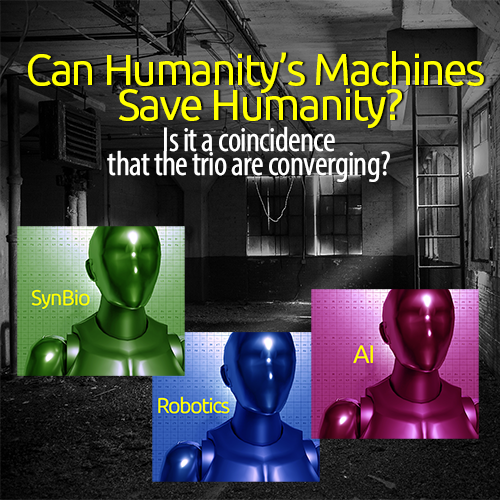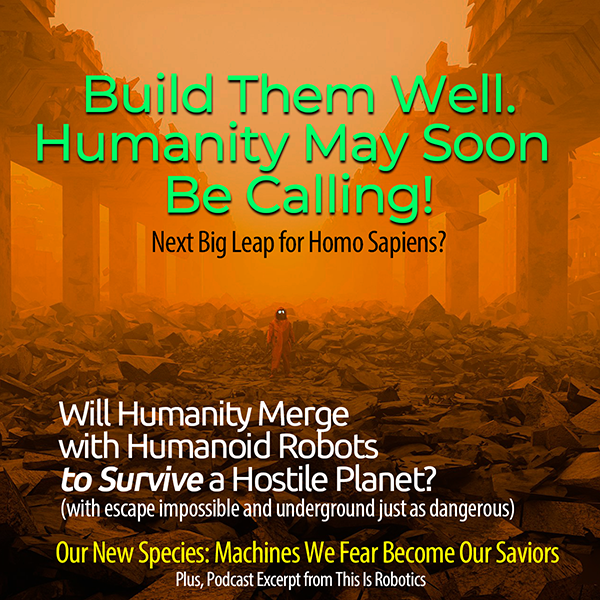
Can Humanity’s Machines Save Humanity?
Will the convergence of humanoid robotics, artificial intelligence, and synthetic biology be the trio that saves humanity from itself?
Now comes SynBio: Is Synthetic Biology the Missing Link?
When Earth has had enough of her spoiled children what will she do? When the inheritors of the great blue orb have willingly destroyed probably the only place in the universe where their kind can prosper and thrive, will they desperately rush for salvation to their newest creations: humanoid robots, artificial intelligence (AI), and synthetic biology (SynBio)?

Will humanity seek refuge in humanoid robots, assisted and supported by AI, and synthetic biology (SynBio)as the planet becomes less and less hospitable and habitable for intelligent, air-breathing, carbon-based life forms?
When mass extinction is near inevitable and mass escape from planet Earth impossible, for all but a few, will the objects of present-day terror—robots and AI—become the blessed objects of human salvation?
Now comes SynBio in the form of “hybrid peptide-DNA nanostructures,” which are DNA and peptides, “some of the most important biomolecules in nature, making DNA technology and peptide technology the two most powerful molecular tools in the nanotechnological toolkit today.
Nature uses both DNA and peptides to build various protein factories found in cells, allowing them to evolve into organisms.”
According to molecular geneticist Ryan Bethencourt: “Synthetic biology (SynBio) is a multidisciplinary field of science that focuses on living systems and organisms, and it applies engineering principles to develop new biological parts, devices, and systems or to redesign existing systems found in nature.
“It includes designing and constructing biological modules, biological systems, and biological machines, or re-designing existing biological systems for useful purposes. Additionally, it is the branch of science that focuses on the new abilities of engineering into existing organisms to redesign them for useful purposes.”
“The potential for synthetic biology and biotechnology is vast; we all have an opportunity to create the future together.”
Recently, “associate professor Chenguang Lou from the Department of Physics, Chemistry, and Pharmacy, University of Southern Denmark, together with Professor Hanbin Mao from Kent State University, created a special artificial hybrid molecule that could lead to the creation of artificial life forms. Their discovery is reviewed in The Medicine of the Future Could Be Artificial Life Forms (Science News) October 2023.
“Hanbin Mao and Chenguang Lou have succeeded in linking designed three-stranded DNA structures with three-stranded peptide structures, thus creating an artificial hybrid molecule that combines the strengths of both.”
The field is called “hybrid peptide-DNA nanostructures,” and it is an emerging field. Lou’s vision is to create viral vaccines (modified and weakened versions of a virus) and artificial life forms that can be used for diagnosing and treating diseases.
Will humanity be forced to merge with humanoid robots to escape a hostile planet Earth?
Science fiction is rife with fanciful tales of deadly organisms emerging from the ice and wreaking havoc on unsuspecting human victims.
From shape-shifting aliens in Antarctica, to super-parasites emerging from a thawing woolly mammoth in Siberia, to exposed permafrost in Greenland causing a viral pandemic – the concept is marvelous plot fodder.
 But just how far-fetched is it? Could pathogens that were once common on Earth – but frozen for millennia in glaciers, ice caps and permafrost – emerge from the melting ice to lay waste to modern ecosystems? The potential is, in fact, quite real.
But just how far-fetched is it? Could pathogens that were once common on Earth – but frozen for millennia in glaciers, ice caps and permafrost – emerge from the melting ice to lay waste to modern ecosystems? The potential is, in fact, quite real.
In 2003, bacteria were revived from samples taken from the bottom of an ice core drilled into an ice cap on the Qinghai-Tibetan plateau. The ice at that depth was more than 750,000 years old.
In 2014, a giant “zombie” Pithovirus sibericum virus was revived from 30,000-year-old Siberian permafrost.
And in 2016, an outbreak of anthrax (a disease caused by the bacterium Bacillus anthracis) in western Siberia was attributed to the rapid thawing of B. anthracis spores in permafrost. It killed thousands of reindeer and affected dozens of people.
More recently, scientists found remarkable genetic compatibility between viruses isolated from lake sediments in the high Arctic and potential living hosts.
Earth’s climate is warming at a spectacular rate, and up to four times faster in colder regions such as the Arctic. Estimates suggest we can expect four sextillion (4,000,000,000,000,000,000,000) microorganisms to be released from ice melt each year. This is about the same as the estimated number of stars in the Universe.

